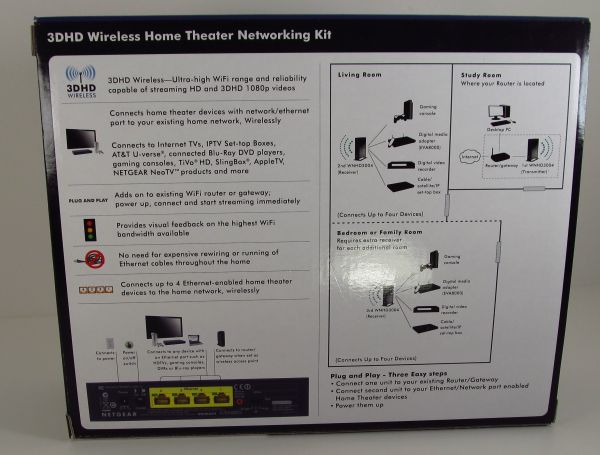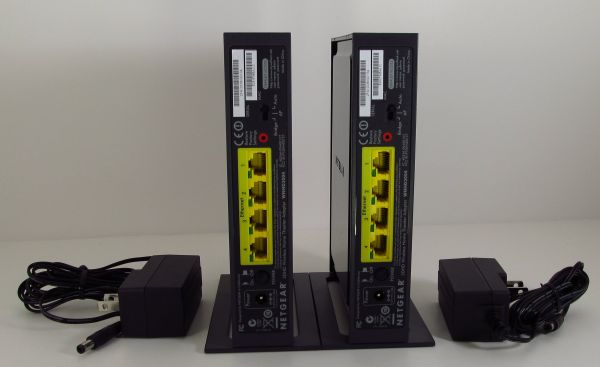Netgear 3DHD Wireless Home Theatre Networking Kit
by Cameron Butterfield on February 25, 2011 7:20 PM EST- Posted in
- Networking
- Home Theater
- NetGear
NETGEAR officially lists this product on its website under the Home Theatre section, which may seem strange for a networking device that is in reality a TCP/IP 802.11x device. However, looking at the packaging reinforces the marketing decision that NETGEAR has made.
The NETGEAR 3DHD kit comes with a pair of WNHD3004 devices. Tthese two units come paired from the factory to work with each other out of the box. Additional WNHD3004 devices can be added to the networking configuration as needed.
The kit (WNHDB3004) includes:
- 2x Networking Units (WNHD3004)
- 2x AC Power adapters
- 2x 6' Ethernet cables
- 1 Instruction Guide
- 2x Detachable Stands
Since the two adapters in the kit come paired from the factory, there is very little configuration required; the devices worked plug and play. Connect one unit to your existing router or switch, and the other to your devices at the remote location. If desired the devices can be changed from the AUTO setting to specifically declare the device the access point or the bridge device. The units have reset buttons and also include switches for turning the device on and off.
The front of the device is simplistic. It features one WPS button, for when the device is acting as the access point, and two indicator LEDs. One shows that the device has power, and another gives the user some sort of indication of connectivity. Green means the connection exists and is fast, orange for average connectivity, and red for a slow or nonexistent connection.
The device does not make use of gigabit ethernet ports; wireless speeds very rarely exceed 100Mbps, so the addition of gigabit ports would only be useful for the communication of devices between each other on the other side of the bridge. Most users would not need to make use of the higher speeds gigabit support would provide in this very specific configuration, and NETGEAR has opted to keep costs down by utilizing 100Mbps ports.














37 Comments
View All Comments
ChronoReverse - Friday, February 25, 2011 - link
Why do the positions of the tested devices vary across each chart? It would be much better if the NETGEAR 3DHD was always the first one in each graph.JarredWalton - Friday, February 25, 2011 - link
It's a glitch with the multibar charts in our engine. Sorry.Slash3 - Saturday, February 26, 2011 - link
30 seconds in MS Paint's cut/paste can reverse the positions. :)JarredWalton - Saturday, February 26, 2011 - link
30 seconds in the graphing engine. Then save that image from your browser onto your drive. Open that image up in Paint (or more likely, Photoshop). Then rearrange the bars so that they're in the positions you desire. Don't mess up the text or the spacing of the bars. When you're done, save the file, upload it back to the server, and then modify the HTML to reference the appropriate file. Yeehaw! I'd guess more like 5 minutes. Now do that for every graph you want to modify.I'll make a note to our engine guy that sorting of multi-series charts doesn't work. Then hopefully we can get that fixed for the future. Having done manual creation of charts in the past, though, I can tell you that it isn't even remotely fun. In fact, the old graphing engine was seriously one of my least liked parts of writing articles. The new engine is worlds better, but it isn't perfect.
LeftSide - Friday, February 25, 2011 - link
Wow, I wireless device that is reliable, has consistent throughput, and is easy to set up. This is a first.danjw - Friday, February 25, 2011 - link
You mention that for short range there were lower priced options that performed just as well for wireless HDMI, so which ones are those?nubie - Friday, February 25, 2011 - link
I think he meant that the other devices it was compared to, not HDMI links.If you needed to go one room over, or through one wall or floor, the other devices reviewed were faster.
Kyser Soze - Friday, February 25, 2011 - link
It's testament to the quality of anandtech's site that they check throughput on various levels of emotional content in films. No other tech sites offer this service. I for one am looking forward to finding out if some stuttering occurs during the Shawshank Redemption, but not, for instance, in Attack of the Clones.Can my old netgear handle romantic comedies?
queequeg99 - Friday, February 25, 2011 - link
This is a pretty funny comment. Did the author intend to refer to a detailed scene with lots of movement?Exelius - Friday, February 25, 2011 - link
If you're somewhat technical, just pick up a pair of compatible wireless devices and load them with DD-WRT, then set one of them up in bridge mode.I have a pair of 5 year old Linksys WRT54Gs that I have doing exactly this. Throughput isn't spectacular by ethernet standards (averages about 30 mbps) but it's more than enough to stream 720p Netflix to my PS3. The devices are about 50 feet apart and cost me about $300... 5 years ago. They can certainly be found for less now. Bonus with DD-WRT is that you can basically "overclock" the wireless radios and operate them with a higher signal strength (though be careful; heat quickly becomes an issue and the case on one of my devices is warped from high heat output in a poorly ventilated area.)
I'm sure this solution is easier to set up, but honestly, it's a set-it-and-forget-it solution. Any self-respecting tech nerd should be able to set this up in an hour or two and enjoy the fruits for years. That said, wireless links can be finicky and a pain in the ass to diagnose when things go wrong, so wired is always preferable even when speed isn't a factor (it doesn't get screwed up by using the microwave.)